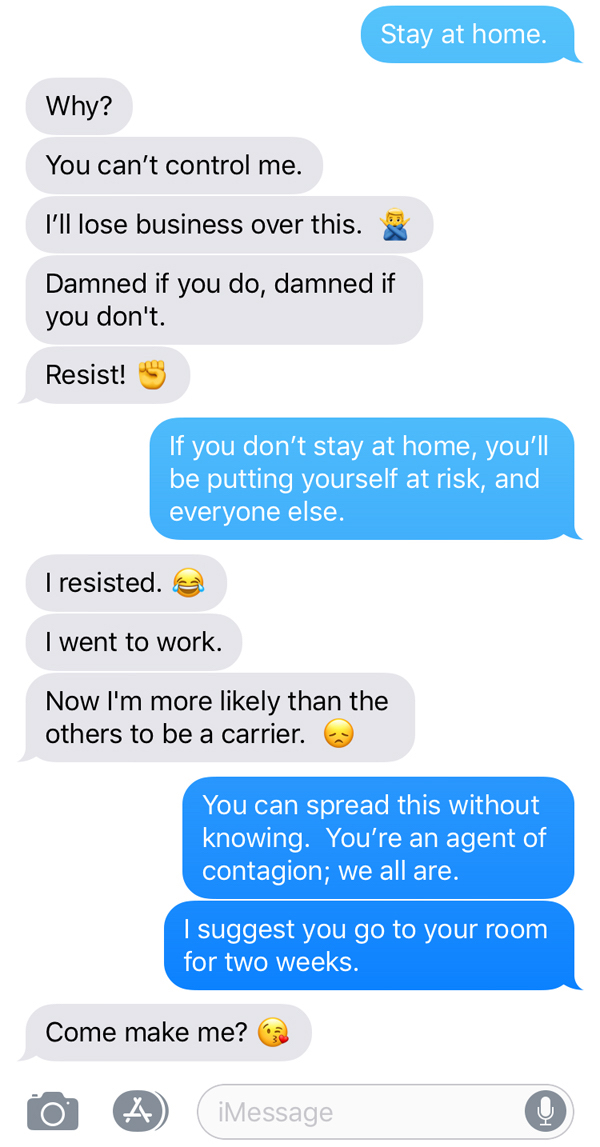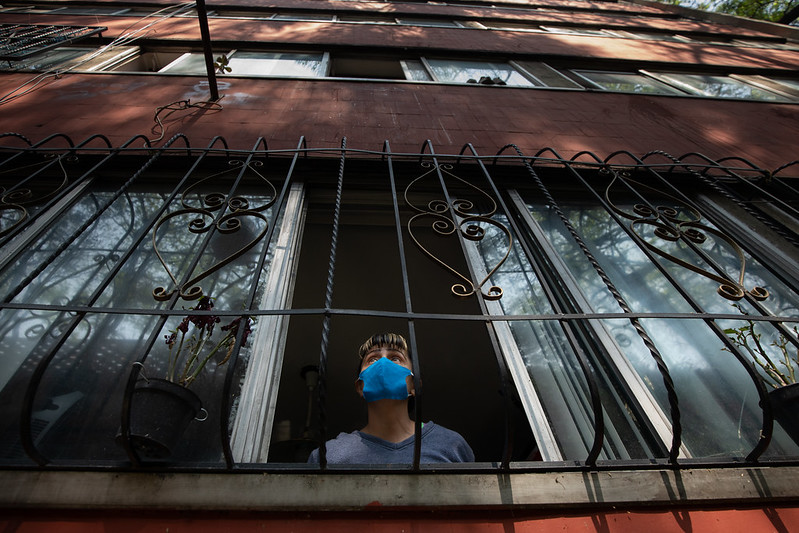Public health / Community resilience
Comment
Viral destabilisation: psychosocial design in the era of COVID-19
20 Apr 2020 | 0
The risks presented by COVID-19 provide opportunities for governments and agencies of power to promote new forms of social order by capitalising on vulnerable communities. Alan Waxman describes how this can manifest and why designers should be aware of the biocapital of vulnerable groups in efforts to create community resilience.
The classic power dynamic, a ‘double bind’,1 highlighted in Figure 1, re-articulates the relationship of the state as knowing parent and the citizen as (dis)obedient child. The more the citizen/child struggles in resistance, the more troublesome he or she becomes, eventually resulting in a necessary ‘time out’ for two-week quarantine. The citizen/child understands that this is a position of power, albeit a risky one.
The negotiation of power here is very familiar within the realm of civic control. Traffic laws, along with many other social mores we take for granted, play out in this way. As the viral nature of social media heightens the potency and scale of this double bind, society becomes destabilised on a similarly ‘viral’ scale. The opportunity presents itself for systems-wide redesign of power dynamics. 
This process of ‘viral destabilisation’ is fast becoming an opportunity for states to seize greater power by capitalising on structural vulnerability as well as vulnerable communities. Designers should therefore be keenly aware of viral destabilisation and understand how agencies can use it – and indeed are using it – to shift power dynamics.
Viral destabilisation is a ‘viral’ psychosocial design/statecraft2,3 strategy to reroute power dynamics. Deploying this strategy typically leads to the following:
- Public awareness of real structural vulnerabilities, such as risk due to the SARS-CoV-2 virus, is ‘virally’ heightened by social media.
- As individuals and communities fail to heed government and agency dictates, they become sites of greater vulnerability and health risk.
- As these people fall victim to the virus, their stories – of personal infringement, failure, and comeuppance – are amplified by viral social media; and the result is an intensified public awareness of risk with the need to follow dictates underlined.
- As victims are framed as perpetrators, they lose their ability to choose how they live or where they go; their rights are slowly surrendered to a group of overseers in a position of authority.
- In the confusion and division that follows, agencies with newfound authority position themselves as problem-solvers, proposing and implementing designs of new social and material order.
The psychosocial epidemiology of viral destabilisation follows an ecosocial precedent;4 historical outlier communities have difficulty following dictates owing to structural challenges, and therefore take on greater risk. Many individuals in these communities can’t work from home, for example, and must put themselves and their families at increasing risk in order to survive. The home environment may also be more crowded than other communities, with multiple family members of all generations sharing rooms, childcare, bathrooms and kitchens. These basic elements mean that communities marginalised prior to COVID-19 will probably bear the greatest burden of health struggle and loss, a trend that data is already beginning to reveal in New York and the Eastern USA.5-8
As viral media emphasise these inequalities, there is a possibility that a polarity may be created between groups labelled with the stigma of risk and those labelled as lacking risk. The most extreme and negative outcome may be that some groups, those hardest hit, may actually be blamed with spreading the virus or failing to maintain quarantine.9
Once viral destabilisation reaches a certain chaotic fever pitch, agencies looking to gain power may seize on the division and confusion to amplify their own voices and solutions. In an effort to create ‘unity’, some agencies of power may claim that force needs to be used to keep populations together, taking control and mandating police-enforced quarantine for groups. Already in China, a tiered, colour-coded system of social control has been established to manage risk,10 and there are discussions of how this might be applied in other situations. 
The most extreme and dystopian ‘solution’ would be the removal of groups in a twisted justification of solidarity. Most likely, domestic groups will be incorporated into a meritocracy of risk or face consequences.
In the United States today, marginalised groups who stray from adherence to the established financial capital-based meritocracy risk punishment through mass incarceration. In the new post COVID-19 economy, outliers may be more vulnerable to biopsychosocial infirmity.
Environmental design in the new economy of biocapital
The art of this new urban and state psychosocial design will be to show how extremely dependent those in positions of authority are on those in positions of vulnerability. The greater the vulnerability, the greater biocapital that individuals and groups hold.
Some with capital in the old system will eagerly retreat behind a wall of Amazon trucks to stockpile food and goods. They will attempt to demand, from a distance, that all workers wear surgical gloves all the time. But this will all be in vain without a consideration of the full lived context of each worker in the supply chain.11
All physical labourers now carry a great deal more social capital that comes with their risk. Doctors, nurses and home health aides because their work brings them into such close proximity with the virus; but also Amazon drivers, Uber Eats delivery people, and strawberry pickers, as it is these individuals who bear the greatest risk for themselves and take on risk for society as a whole.12 Workers in these essential services, not the white-collar ‘work from home’ types, are the potential vectors of societal survival or disarray.
What is housing like for people with these jobs? What are the conditions of their work environments? Do people cram into beds in small apartments and share bathrooms and kitchens?13,14 Do workers pack into sweat-filled, overheated rooms stacking boxes to be delivered,15,16 and then rush delivery under constant threat of losing their job?17,18
The conditions of the most vulnerable are now central to society. The environment of basic workers is primary in considering how to build long-term resiliency in a new COVID-19 resistant world. In short, the conditions of our most vulnerable are the new measure of our resiliency.
Although viral social media often highlights victims as perpetrators, amplifying fears and divisions, we will do well to recognise that these ‘pain points’ are critical elements of transformation in the whole. These locations, structures and communities are sites of the new ‘viral’ environmental design. The most vulnerable of all social stripes are in the hands of the most vulnerable in society.
References
- Bateson, G. Steps to an ecology of mind: collected essays in anthropology, psychiatry, evolution, and epistemology. University of Chicago Press, 2000.
- Povinelli, EA. Geontologies: a requiem to late liberalism. Duke University Press, 2016.
- Foucault, M. Madness and civilization: a history of insanity in the age of reason. Vintage, 1988.
- Krieger, N. ‘Theories for social epidemiology in the 21st century: an ecosocial perspective.’ International Journal of Epidemiology; 30.4, 2001: 668-677.
- Eligon, J, Berch, A, Searcey, D, Oppel Jr, RA. ‘Black Americans face alarming rates of Coronavirus infection in some states’. NYTimes, 7 April, 2020. https://www.nytimes.com/2020/04/07/us/coronavirus-race.html
- Gray, M. ‘US Surgeon General Jerome Adams on COVID-19’s disproportionate impact on black America’. CBS News, 9 April, 2020. https://www.cbsnews.com/news/coronavirus-us-surgeon-general-jerome-adams-covid-19-disproportionate-impact-black-america/
- Aubrey, A. ‘CDC hospital data point to racial disparity in COVID-19 cases’. NPR, 8 April, 2020. https://www.npr.org/sections/coronavirus-live-updates/2020/04/08/830030932/cdc-hospital-data-point-to-racial-disparity-in-covid-19-cases
- Gonen, Y, Choi, A, Velasquez, J. ‘NYC blacks and Hispanics dying of COVID-19 at twice the rate of whites, Asians’. The City, 8 April, 2020. https://thecity.nyc/2020/04/nyc-blacks-and-hispanics-dying-of-covid-19-at-twice-the-rate.html
- Shuham, M. ‘In New York’s sickest county, Hasidic Jews feel the extra scrutiny’. TPM, 8 April, 2020. https://talkingpointsmemo.com/news/in-new-yorks-sickest-county-hasidic-jews-feel-the-extra-scrutiny
- Yineng, C. ‘On China’s ‘Color Codes’ and life after COVID-19’. Sixth Tone, 9 April, 2020. http://www.sixthtone.com/news/1005452/on-chinas-color-codes-and-life-after-covid-19
- Fisher, M, Bubola, E. ‘As Coronavirus deepens inequality, inequality worsens its spread’. NYTimes, 16 March, 2020. https://www.nytimes.com/2020/03/15/world/europe/coronavirus-inequality.html?action=click&module=RelatedLinks&pgtype=Article
- Choi, A, Velasquez, J, Welch, W. ‘Queens neighborhoods hardest hit by virus home to many service workers’. The City, 2 April, 2020. https://thecity.nyc/2020/04/queens-neighborhoods-housing-service-workers-hardest-hit.html
- Calma, J. ‘America set up black communities to be harder hit by COVID-19’. The Verge, 8 April, 2020. https://www.theverge.com/2020/4/8/21213974/african-americans-covid-19-coronavirus-race-disparities
- Harris, M. ‘Why the Coronavirus is hitting black Americans hardest’. Slate, 8 April, 2020. https://slate.com/technology/2020/04/coronavirus-covid19-black-americans-impact.html
- Van der Leun, J. ‘The Amazon warehouse worker who can’t stay home’. Gen, Medium, 24 March, 2020. https://gen.medium.com/im-an-amazon-warehouse-worker-this-crisis-is-making-life-hell-for-us-28dd3780c0e7
- Brady-Turner, C. ‘The relentless misery of working in an Amazon warehouse. OneZero, Medium, 11 March, 2019. https://onezero.medium.com/relentless-com-life-as-a-cog-in-amazons-e-tail-machine-d46b3ef05eb8
- Russell, L. ‘The Silicon Valley economy is here, and it’s a nightmare’. The New Republic, 16 January, 2020. https://newrepublic.com/article/156202/silicon-valley-economy-here-its-nightmare
- Ladd, B. ‘Amazon is hell on wheels for delivery drivers’. Forbes, 13 September, 2018. https://www.forbes.com/sites/brittainladd/2018/09/13/hell-on-wheels-what-its-like-to-be-a-delivery-driver-for-amazon/#29494c80219a
Organisations involved
